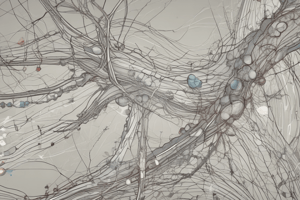Podcast
Questions and Answers
What initiates the generation of an action potential?
What initiates the generation of an action potential?
- A hyperpolarizing stimulus
- Constant resting membrane potential
- A graded potential that exceeds a threshold (correct)
- Passive spread of potential
How does continuous propagation occur in unmyelinated neurons?
How does continuous propagation occur in unmyelinated neurons?
- Via local currents leading to sequential activation of voltage-gated Na+ channels (correct)
- By preventing the influx of sodium ions
- By the simultaneous activation of all voltage-gated Na+ channels
- Through the release of neurotransmitters
What is the primary advantage of saltatory propagation in myelinated fibers?
What is the primary advantage of saltatory propagation in myelinated fibers?
- It allows ions to cross the membrane at multiple points
- It conserves energy by reducing the number of ion exchanges across the membrane (correct)
- It results in slower impulse transmission
- It increases the amplitude of action potentials
What characteristic of action potentials differentiates them from graded potentials?
What characteristic of action potentials differentiates them from graded potentials?
Which of the following statements about nerve conduction velocity is accurate?
Which of the following statements about nerve conduction velocity is accurate?
What role do nodes play in the propagation of action potentials in myelinated fibers?
What role do nodes play in the propagation of action potentials in myelinated fibers?
In what way do graded potentials differ in response to stimuli compared to action potentials?
In what way do graded potentials differ in response to stimuli compared to action potentials?
What condition primarily affects the myelinated fibers in relation to their insulating sheath?
What condition primarily affects the myelinated fibers in relation to their insulating sheath?
Flashcards
Continuous Propagation
Continuous Propagation
The propagation of an action potential along an unmyelinated axon, where the signal travels continuously from one point to the next.
Saltatory Propagation
Saltatory Propagation
The propagation of an action potential along a myelinated axon, where the signal 'jumps' from one node of Ranvier to the next.
Nerve Conduction Velocity
Nerve Conduction Velocity
The speed at which a nerve impulse travels along an axon.
Resting Membrane Potential
Resting Membrane Potential
Signup and view all the flashcards
Graded Potential
Graded Potential
Signup and view all the flashcards
Action Potential
Action Potential
Signup and view all the flashcards
Synapse
Synapse
Signup and view all the flashcards
Multiple Sclerosis (MS)
Multiple Sclerosis (MS)
Signup and view all the flashcards
Study Notes
Neuronal Physiology - Action Potential Propagation
- Action potentials are produced by a graded potential exceeding a threshold
- They propagate along the axon surface to the nerve terminal and synapse
- Action potentials are electrical impulses and frequency signals
- Synaptic activity involves the transmission of information between neurons at synapses
Action Potential Propagation (Unmyelinated Nerves)
- Action potentials are propagated due to local currents reinforcing signal activation of voltage-gated sodium channels
- A new action potential is generated sequentially along the axon
- This method of propagation is relatively slow
Myelinated Fibers
- Myelin acts as an insulator, restricting membrane potential to the nodes of Ranvier
- Ions can only cross the membrane at these nodes
- Conditions like Multiple Sclerosis and Guillain Barré syndrome can affect myelin
Saltatory Propagation
- In myelinated axons, action potentials "jump" from node to node (saltatory = jumping)
- Local currents rapidly propagate between nodes
- This method of propagation is faster than continuous propagation
- Less energy is used compared to continuous propagation because fewer ions cross the membrane
Nerve Conduction Velocity
- Nerve conduction velocity is influenced by the nerve type, diameter, and myelination
- Larger diameter axons and myelinated axons generally have faster conduction velocities
- Somatic motor fibers (large diameter, myelinated) have very fast velocity (80-120 m/sec)
- Sensory C fibers (small diameter, unmyelinated) have a slower velocity (0.5-2.0 m/sec)
Summary of Graded vs Action Potentials
| Feature | Graded Potentials | Action Potentials |
|---|---|---|
| Depolarization/Hyperpolarization | Yes | Only depolarizing |
| Threshold Level | No | Yes |
| Amplitude | Varies with stimulus intensity | All-or-none; fixed amplitude |
| Spread | Passive; decreases with distance | Propagated along the entire membrane |
| Summation | Possible | Not possible |
| Refractory Period | No | Yes |
| Location | Most plasma membranes | Excitable membranes (neurons and muscle cells) |
Studying That Suits You
Use AI to generate personalized quizzes and flashcards to suit your learning preferences.





